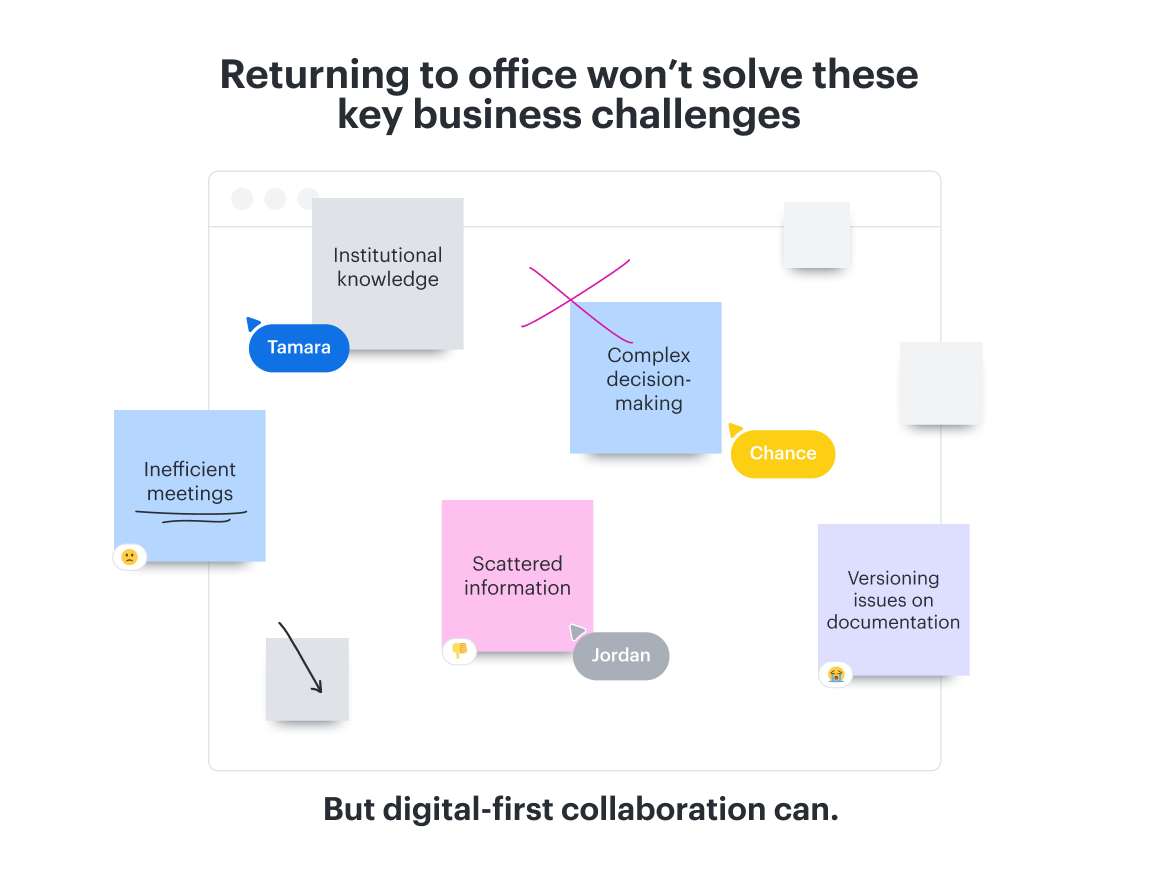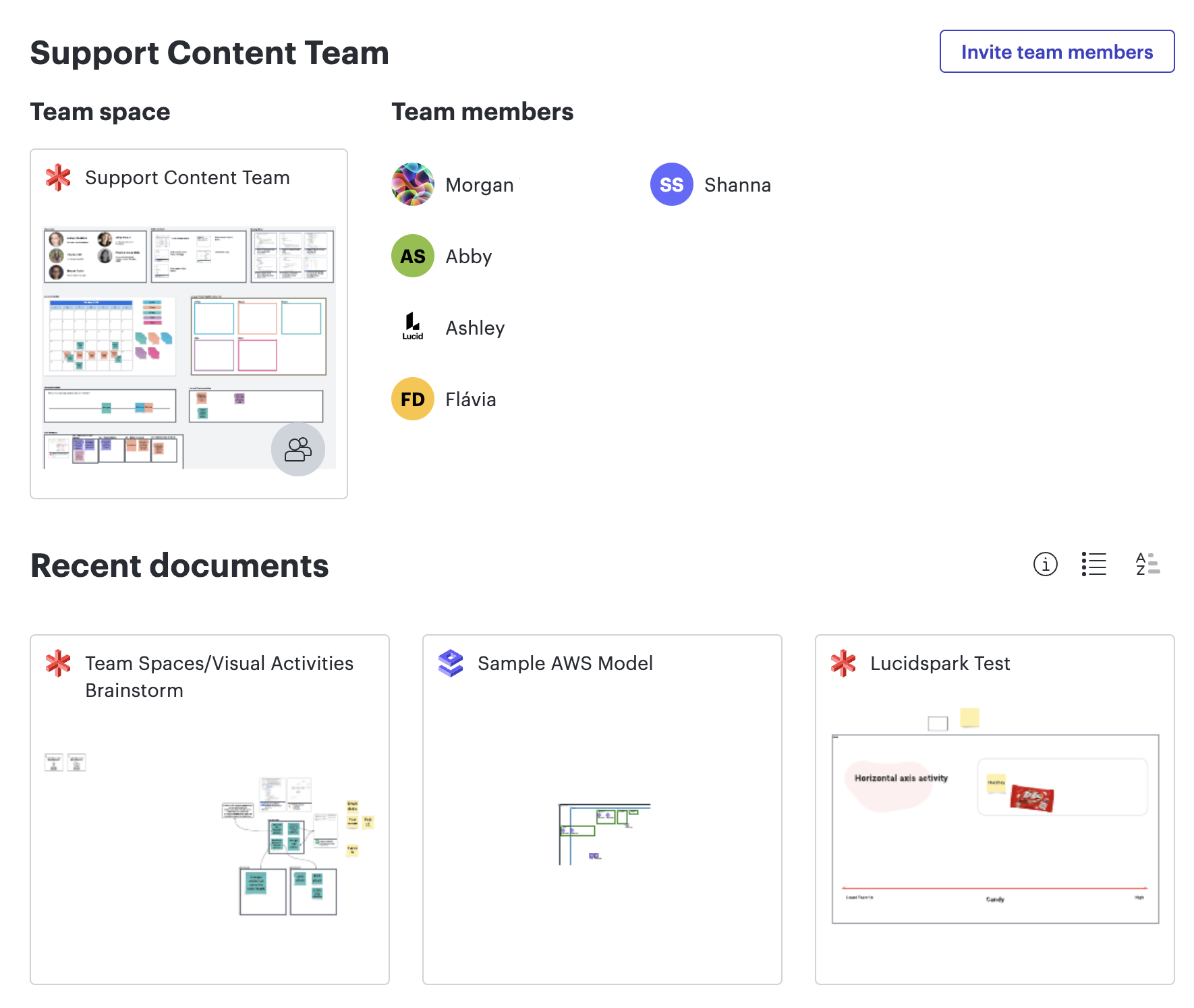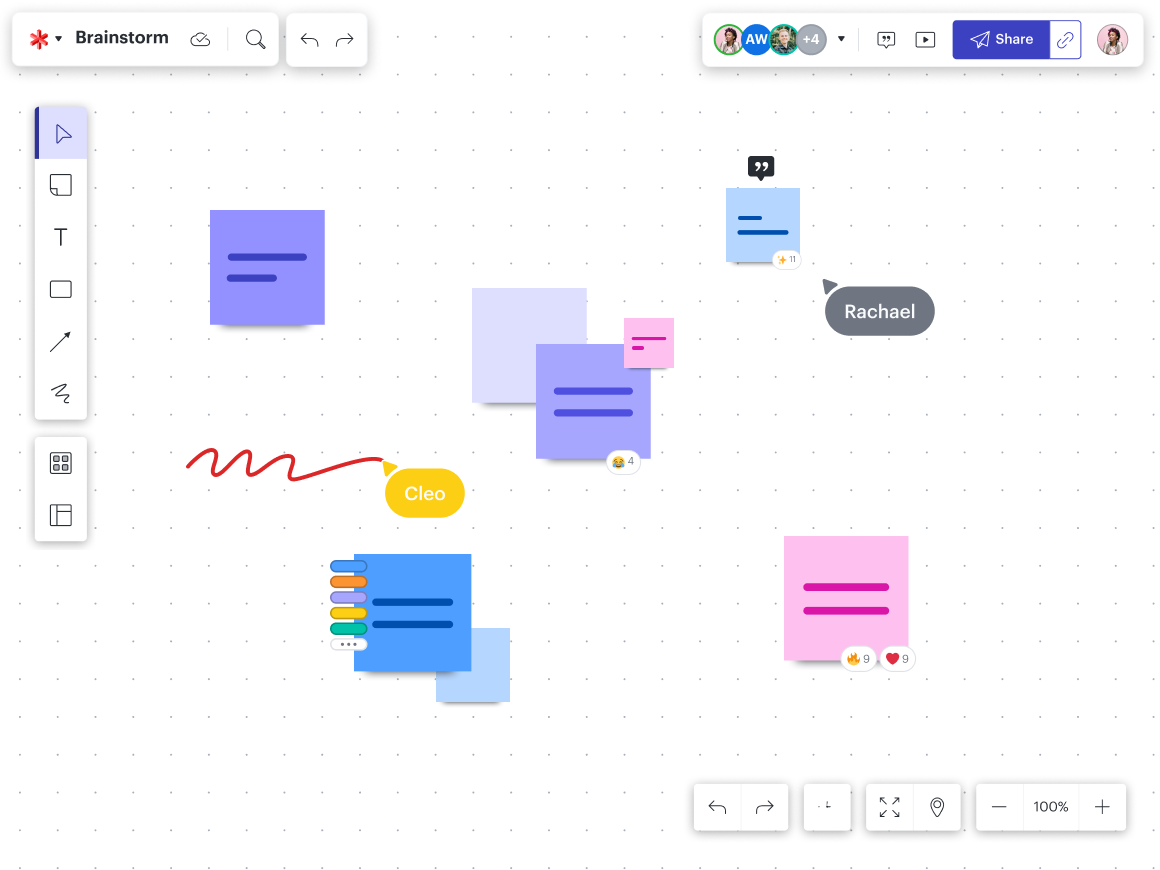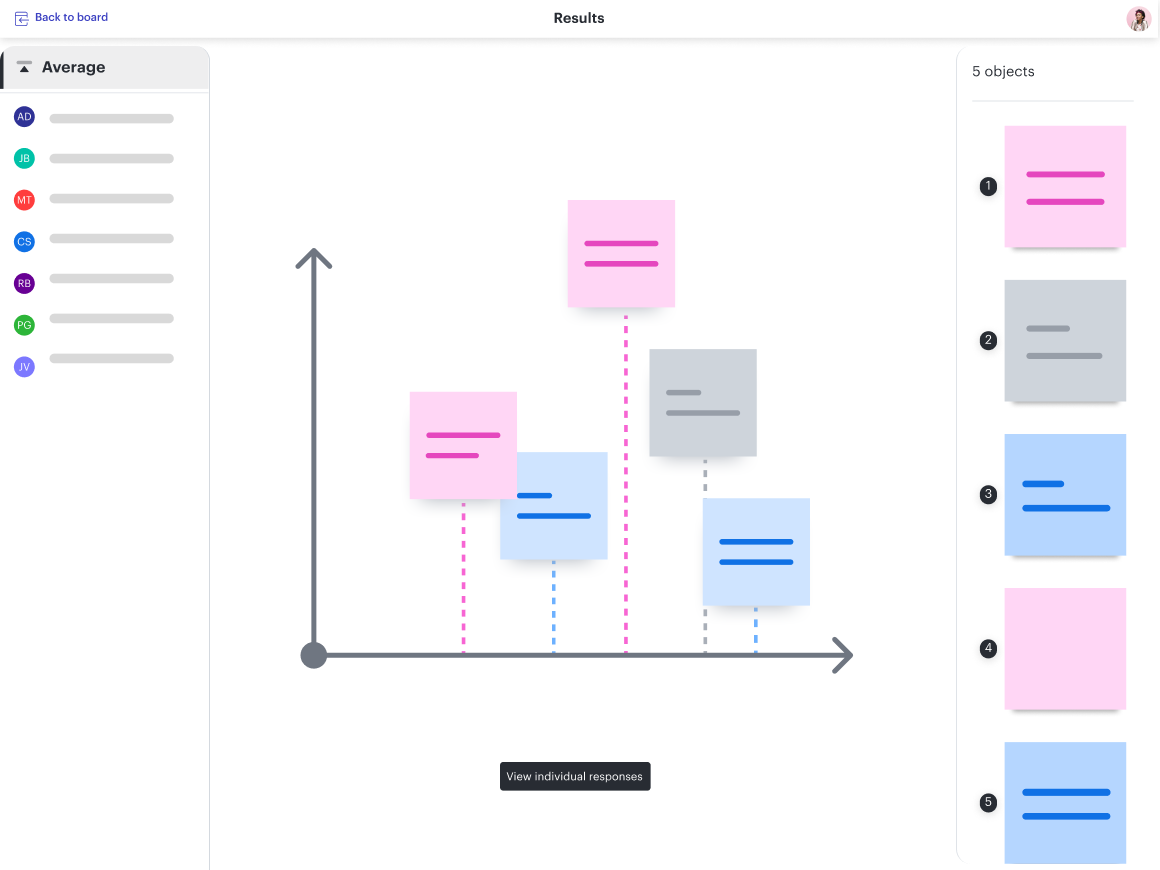
Why a return-to-office policy isn't a silver bullet to business problems
Reading time: about 7 min
Topics:
The pandemic changed the way we work, with millions of people transitioning overnight to a work-from-home model.
Despite the fact that 98% percent of surveyed workers would like to continue working remotely, at least some of the time, many leaders have been anxious to return their teams to the office.
As a result, more and more companies are reconsidering their remote or hybrid work policies. In fact, 9 out of 10 companies plan to implement return-to-office policies by the end of 2024.
The impulse to send teams back to the office is partly driven by the belief that in-person work naturally leads to better collaboration and improved productivity. But this isn’t always the case.
Whether or not employees are working remotely or together in person, they’re still subject to many of the same challenges:
- Scattered information
- Institutional knowledge
- Inefficient meetings
- Versioning issues on documentation (or lack of documentation altogether)
- Miscommunication
In other words: Returning to office is not a cure-all to these issues.
If there’s one thing remote work showed us, it’s that we need to adjust the way we work together—whether we’re in person, remote, or a mix of the two.

Why return-to-office policies aren’t the cure-all solution to your business problems
In-person collaboration won’t cure fundamental collaboration issues. That’s because remote work isn’t the cause of most collaboration issues. However, it has revealed existing problems in the way we work together.
As we’ve observed the trend unfold, there are a few key learnings leaders need to take on board as they navigate their own potential return-to-office policy.
Return-to-office won’t fix knowledge silos or gaps
Even before the pandemic, teams never were (and never really will be) 100% in-person teams. There will always be people on different floors or in different office locations, employees out sick or on vacation—you get the idea. That means there will always be alignment gaps and knowledge silos to grapple with.
This is an age-old problem for office work. For example, important ideas surfaced during informal “water cooler chats” still need to be documented and shared somehow. Otherwise, that information can get lost, obfuscated, or unequally distributed—which can leave key stakeholders out of the loop, delay action, and potentially cause redundancies and frustration.
Plus, even when employees do keep everyone looped into their conversations, they typically use multiple communication channels (like email and Slack), so information is still scattered across various places.
Return-to-office doesn’t help teams move into action faster
The recent romanticism of the in-person whiteboarding session, where ideas and creativity flow like a river of gold, is a nice thought. But the truth is most teams never focus on documenting these sessions and capturing that innovative thinking well enough for other individuals and teams to build on.
Picture it: You gather your team together in the meeting room and start brainstorming. The energy and enthusiasm are there, and soon, you have some great ideas bouncing around. Even if you’re able to write all of them on the whiteboard, the only documentation teammates have are a few notes on their laptop or notebook and maybe a picture of the board on their phone. There isn’t any centralized documentation or an easy way to record those ideas long-term—let alone organize and prioritize them for later action.
Bottom line: The future of work—whether in the office, at home, or a mix of both—requires modern solutions to old problems.
Return-to-office doesn’t account for different collaboration styles
Effective collaboration isn’t just about getting together in a room. In fact, this one-size-fits-all approach can inadvertently leave out team members with different collaboration styles.
In other words, “ideal collaboration” takes many forms—some need time to sit with ideas before sharing, some prefer large blocks of asynchronous deep work, and some might thrive in off-the-cuff discussions.
But traditional, in-office work doesn’t naturally account for these differences. And if you impose one collaboration style for your company and ignore how a large part of your workforce might prefer to work, you’re going to run into many of the same collaboration issues you did before going remote—and innovation and productivity will suffer for it.
No matter where your teams work, prioritize digital-first collaboration
No matter what your return-to-office plan looks like, you can’t rely on traditional verbal or written communication alone anymore. Effective collaboration, in the office or at home, needs to be grounded in digital solutions.
Digital-first collaboration creates natural, effortless documentation in real time that all workers can reference—anytime, anywhere.
Unlike traditional in-person approaches, cross-functional collaboration in digital spaces leaves a natural record of documentation in its wake, increasing alignment and knowledge-sharing.
For example, instead of handwriting ideas on a physical whiteboard and spending valuable time transcribing those ideas to share later (with lots of info getting lost in the shuffle), a digital-first solution enables you to document as you go in a shared space where everyone can contribute equally and refer to whenever they need.
Digital-first collaboration naturally creates a repository of ideas, insights, processes, and plans that team members can reference, align on, and take action on faster. And if an employee missed a meeting or was out of office, they can access this repository at any time, anywhere, to get all the context they need.
Digital-first collaboration creates natural, effortless documentation in real time that all workers can reference—anytime, anywhere.

Digital-first collaboration guide
Learn what strategies and tools are needed to help your org adopt digital-first collaboration.
Learn moreHow Lucid supports a variety of return-to-office initiatives
Visual collaboration solutions like Lucid are one of the most effective ways organizations can prioritize digital-first collaboration to solve some of their greatest business challenges. Lucid bridges the gap between employees no matter where they work in a few ways:
Centralizes documentation
The Lucid Visual Collaboration Suite increases clarity and understanding while creating single-source-of-truth documentation. Easily go back and forth between in-person and virtual work as a team without losing context simply by working from a single canvas.
Use team hubs as your central hub to keep teams on the same page and store your work to reference in in-person and virtual meetings alike.

Supports all collaboration styles
Lucid helps people play to their strengths when collaborating—leading to better communication, better ideas, and better results.
For those who prefer to individually gather their thoughts, Lucid makes it easy to communicate asynchronously, giving you time to think and plan without pressure. When it comes time to brainstorm live, Lucid’s template library and features like tagging, commenting, Collaborator Colors, and Breakout Boards enable dynamic brainstorming and interactive collaboration with your peers.
With Lucid, everyone has a chance to contribute ideas and feedback in a shared space. And when everyone’s working from the same canvas, it’s easy for teams to reach alignment and make decisions, no matter where they’re working from. In fact, some leaders, such as Brad Rencher, CEO of BambooHR, can’t imagine returning to old ways of working without Lucid— even if they do return to the office.
“There need to be products that act as that context facilitator and discussion aligner. Even if we were in the office, we’d want a screen projecting Lucidspark, and we’d want to use it as our workspace to drive the context and alignment around what we’re discussing.”

Helps your teams jump into action
You just can't automate a physical whiteboard or integrate it with a data source like you can with Lucid. So even if you're all back in person, it's not going to be easy to organize your thoughts, prioritize them, and get the insights you need to actually act on them.
This is where Lucid’s intelligence comes in.
Lucid is purpose-built for intelligent, digital collaboration. This means you can use features like data linking and conditional formatting to automatically visualize data and surface insights. Or to get more out of brainstorms, use Collaborative AI to generate, organize, and summarize ideas so you can move forward faster. And with Visual Activities, teams can gather input, organize it, and spark deeper conversations that build alignment and drive better decision-making.
Put simply: You can’t replicate the efficiency gains and time savings that Lucid’s robust intelligence provides teams with a physical whiteboard.

Solve collaboration wherever you work with Lucid
As teams return to the office, they need solutions that are tailor-made to manage big transitions like this while supporting their work anytime, anywhere.
With hundreds of integrations, Lucid’s intuitive, visual collaboration platform helps you make this move without needing to switch tools or add new ones to make it work.

Want to see just how Lucid can power collaboration for your organization, wherever you’re working? Get in touch with us today.
Request a demoAbout Lucid
Lucid Software is the leader in visual collaboration and work acceleration, helping teams see and build the future by turning ideas into reality. Its products include the Lucid Visual Collaboration Suite (Lucidchart and Lucidspark) and airfocus. The Lucid Visual Collaboration Suite, combined with powerful accelerators for business agility, cloud, and process transformation, empowers organizations to streamline work, foster alignment, and drive business transformation at scale. airfocus, an AI-powered product management and roadmapping platform, extends these capabilities by helping teams prioritize work, define product strategy, and align execution with business goals. The most used work acceleration platform by the Fortune 500, Lucid's solutions are trusted by more than 100 million users across enterprises worldwide, including Google, GE, and NBC Universal. Lucid partners with leaders such as Google, Atlassian, and Microsoft, and has received numerous awards for its products, growth, and workplace culture.
Related articles
The problems with workplace collaboration today—and how to fix them
Uncover the top collaboration problems that organizations can't ignore any longer in this blog by Nathan Rawlins, Lucid CMO.
How to actually increase workplace productivity
Busy doesn’t mean productive. Use these four strategies to increase workplace productivity.
Lessons learned from remote work that you should bring back to the office
Here are six lessons we’ve learned from remote work that you should bring with you to the office.
[Guide] How to set up your hybrid workplace to maximize collaboration
Every team is a hybrid team. Learn how to set up your hybrid workplace with the right office design and culture to maximize collaboration.
